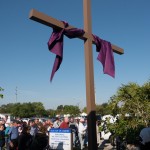
Through the cross to resurrection
Today we commemorate the death of a just man. The traditional explanation since the middle ages has been that Jesus died for our sins. Recognizing the untruth of this statement because God would never demand such from his beloved son, we now say Jesus died because of our sins. It is time to discard Anselm’s medieval caricature of God and any modern renditions. God is not a feudal lord who could never just forgive an unruly serf. God is the God of compassion and love. We can do nothing to make God love us. We can do nothing to make God not love us. We are born in God’s very image and likeness. GOD LOVES US! God will never give up on us even if we give up on ourselves. This is the entire message of the scriptures. When we go away, God keeps coming back to us. God keeps bringing us back to what we are capable of becoming—sons and daughters of the Living God.
Today we ponder the death of Jesus of Nazareth, a death which probably would have gone unnoticed by the media, if there were any media at the time. We ask, “Why?” Why was an itinerant preacher from the backwaters of Galilee crucified by the Romans. The Romans maintained power by fear and oppression. Crucifixion was capital punishment designed to deter those who would dare challenge empire. These who rebelled in Sephoris, near Nazareth, years earlier were hung on crosses lining the roadside to remind people of what happens to those who dare question the vagaries of empire. Perhaps Jesus saw those bodies decaying and being picked clean by vultures as he traveled to work in Caesarea Philippi. Toward the end, he certainly feared going up to Jerusalem because he knew they were out to get him. Mark begins his Gospel with a bold proclamation—Jesus is Lord. Jesus not Caesar is Lord! High treason. The Gospels recount Jesus’ triumphal entry into Jerusalem on a donkey. Pure street theater at its best. Pilate’s legions coming to bolster security during Passover were entering at the same time through another gate on their majestic horses. If Jesus the Christ is Lord, Caesar is not.
Jesus stumbled through the streets of Jerusalem carrying his cross. In a few hours we will take to the streets of Melbourne, Florida to bear witness to the love of Christ. We will march, sing, pray and ask, “”Where is Jesus suffering today?” Joan Chittister says that we will walk as “Easter people, alive in hope, strong in faith and living in love.”
We pray and sing our way through the stations. Our Lady of Lourdes Church. Our lady of Lourdes School. A veterans’ relocation center. The Daily Bread soup kitchen. His Place Ministries shelter. The railroad tracks where we pray for migrants and refugees. City hall where we pray for all governments. We end up at the church for concluding prayers. The theme of the stations is “Where is Jesus suffering today?” We dare ask this question because Eucharist compels us to serve others, especially where Jesus is suffering today. The Pascal Mystery teaches us that we come to new life through suffering and eventually death. In the meantime, Eucharist compels us, the Body of Christ, to ask where Jesus is suffering today and to do what we can to alleviate this suffering.
Listen to Sister Joan Chittister:
Lent is our time to prepare to carry the crosses of the world ourselves. The people around us are hungry; it is up to us to see that they are fed, whatever the cost to ourselves. Children around us are in danger on the streets; it is up to us to see that they are safe. The world is at the mercy of US foreign policy, US economic policy and US militarism; it is up to us to soften the hearts of our own government so that the rest of the world can live a life of dignity and pride. We must “set our faces like flint,” let nothing deter the Jesus life in us, continue the journey from Galilee to Jerusalem, knowing that however our efforts end, the resurrection is surely on its way.
We will be proclaiming once again that Jesus is Lord; Caesar is not.
 On Good Friday, thunder showers and the threat of more thunder showers forced the Good Friday Ecumenical Walk indoors. The organizers were prepared for this contingency. We gathered in Our Lady of Lourdes Church in Melbourne and did a virtual walk with digital images of the “stations.”
On Good Friday, thunder showers and the threat of more thunder showers forced the Good Friday Ecumenical Walk indoors. The organizers were prepared for this contingency. We gathered in Our Lady of Lourdes Church in Melbourne and did a virtual walk with digital images of the “stations.”





